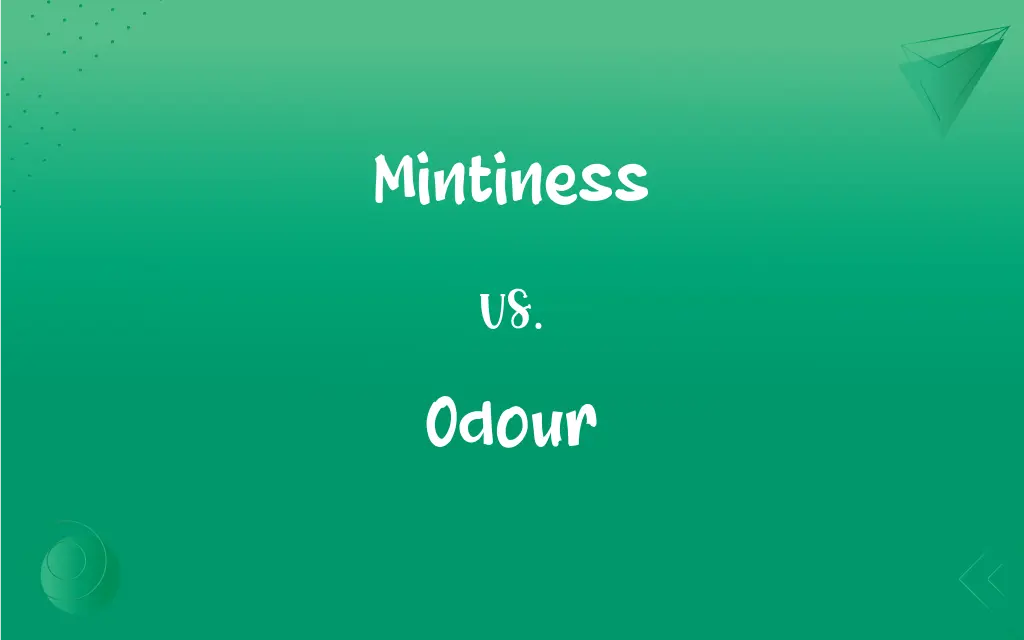Mintiness vs. Odour: What's the Difference?
By Janet White || Updated on May 23, 2024
Mintiness refers to the refreshing, cool taste and aroma of mint, while odour is a general term for any smell, pleasant or unpleasant.

Key Differences
Mintiness describes the specific sensory qualities associated with mint, including its refreshing taste and cool aroma. It's often used to describe food, beverages, and products like toothpaste or gum that have a mint flavor or scent. Odour, on the other hand, is a broad term that refers to any detectable smell, which can be pleasant or unpleasant. It encompasses a wide range of smells from various sources, such as food, chemicals, or nature.
Mintiness is typically associated with a positive, fresh sensation, often linked to cleanliness and coolness. Products with mintiness are popular for their ability to provide a cooling effect and a refreshing breath. Odour, however, is a neutral term that does not imply any specific quality of smell. An odour can be anything from the delightful scent of flowers to the unpleasant smell of garbage.
Mintiness is a more specific term, used mainly in the context of describing something flavored or scented with mint. This term is less common in scientific descriptions and more prevalent in marketing and everyday language. Odour is a more general term, used in both scientific and everyday contexts to describe any smell. It can be used to discuss environmental studies, health issues, or simply describing what someone perceives through their sense of smell.
Products marketed for their mintiness are often associated with personal care and food items, emphasizing their refreshing qualities. Odour, being a broader term, can refer to any smell emitted by various sources, making it relevant in numerous fields from perfumery to environmental science.
Comparison Chart
Definition
Refreshing taste and aroma of mint
Any detectable smell
ADVERTISEMENT
Sensory Quality
Refreshing, cool
Pleasant or unpleasant
Context
Food, beverages, personal care
General smells, environmental
Specificity
Specific to mint
General, various sources
Common Usage
Marketing, everyday language
Scientific, everyday language
Mintiness and Odour Definitions
Mintiness
Cool aroma reminiscent of mint leaves.
The mintiness of the tea was soothing.
ADVERTISEMENT
Odour
A general term for any type of smell.
The odour of garlic lingered in the air.
Mintiness
A fresh, clean sensation from mint flavor.
The toothpaste's mintiness leaves my mouth feeling clean.
Odour
Any detectable smell, pleasant or unpleasant.
The odour from the kitchen was mouth-watering.
Mintiness
Crisp and cool taste associated with mint.
The mintiness of the ice cream was delightful.
Odour
Any scent, often with a neutral connotation.
The room had a musty odour.
Mintiness
The refreshing taste of mint.
The gum has a strong mintiness that freshens breath.
Odour
Smell perceived by the sense of smell.
The odour of fresh paint filled the room.
Mintiness
The quality of having a mint-like flavor.
I enjoy the mintiness in my mojito.
Odour
A distinctive scent or aroma.
The flowers emitted a sweet odour.
Mintiness
The state or condition of being minty.
Odour
Variant of odor.
Odour
(British spelling) odor
Odour
The sensation that results when olfactory receptors in the nose are stimulated by particular chemicals in gaseous form;
She loved the smell of roses
Odour
Any property detected by the olfactory system
FAQs
Is mintiness always pleasant?
Typically, mintiness is considered pleasant and refreshing.
Can odour be used in scientific contexts?
Yes, odour is often used in scientific studies related to environmental science and health.
How does odour differ from mintiness?
Odour is a general term for any smell, while mintiness is specific to the smell and taste of mint.
Can odour be pleasant?
Yes, odour can be pleasant, neutral, or unpleasant.
What is an example of an unpleasant odour?
The odour of rotting food is unpleasant.
What products commonly feature mintiness?
Products like toothpaste, gum, and certain foods and beverages often feature mintiness.
Is mintiness limited to taste?
No, mintiness can refer to both taste and aroma.
Can odour indicate something harmful?
Yes, certain odours can indicate the presence of harmful substances.
Is mintiness used in perfumes?
Yes, mintiness can be an ingredient in perfumes for a fresh scent.
Does mintiness have a cooling effect?
Yes, mintiness often has a cooling, refreshing sensation.
What is mintiness?
Mintiness refers to the refreshing, cool taste and aroma of mint.
Can odour be both natural and artificial?
Yes, odours can come from both natural and artificial sources.
Can odour be detected by all senses?
No, odour is detected by the sense of smell.
What is a common source of mintiness?
Common sources include mint leaves and peppermint oil.
Is mintiness found in nature?
Yes, mintiness is naturally found in mint plants.
Does mintiness imply a specific source?
Yes, mintiness specifically refers to the qualities associated with mint.
Can odour affect mood?
Yes, certain odours can influence mood and emotions.
Can odour be a combination of smells?
Yes, an odour can be a complex combination of different smells.
Can mintiness be artificially created?
Yes, mintiness can be created using artificial flavoring.
Is odour subjective?
Yes, perception of odour can vary between individuals.
About Author
Written by
Janet WhiteJanet White has been an esteemed writer and blogger for Difference Wiki. Holding a Master's degree in Science and Medical Journalism from the prestigious Boston University, she has consistently demonstrated her expertise and passion for her field. When she's not immersed in her work, Janet relishes her time exercising, delving into a good book, and cherishing moments with friends and family.































































